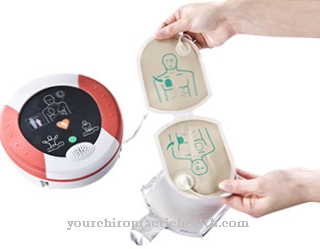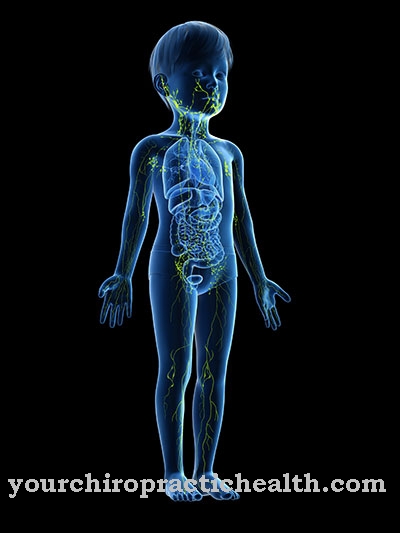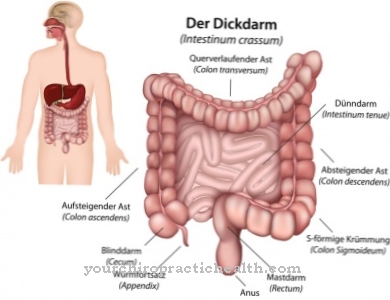A Congestive papilla is an edema in the eye, which can have a number of possible causes and which, if left untreated, can lead to severe visual impairment and even death.
What is a papillae?

© crevis - stock.adobe.com
At a Congestive papilla it is a storage of water, a so-called papillary edema, in the eye, more precisely at the point where the optic nerve meets the retina.
Due to the water retention, a swelling of the optic nerve head becomes visible, which is noticeable by a bulge - usually in both eyes, since the congestive papilla is usually not on one side. The causes of papillae can be many different diseases, each of which requires a different type of treatment.
Although congestive papillae are not common, they can occur in patients of any gender and age group. If a congestive papilla and its causes are not or not adequately treated, it can lead to serious complications with irreparable damage to the optic nerve and even death. If there are signs of a congestive papilla, a doctor's visit is essential.
causes
As the cause of a Congestive papilla several diseases can come into question. The most common cause of papillae congestion is increased intracranial pressure, which in turn is caused by several possibilities.
Reasons for increased intracranial pressure can be diseases such as brain tumors or an inflammation of the brain, for example in the case of meningitis or an abscess. Injuries that cause bleeding in the brain or in the area of the meninges can also lead to increased intracranial pressure.
Malformations of the skull can also lead to higher intracranial pressure and be the cause of congestive papillae. In rare cases, increased intracranial pressure can also be caused by a disruption of the liquor outflow, which can be caused, for example, by a so-called pseudotumor cerebri.
Typical symptoms & signs
- Visual disturbances
- a headache
Diagnosis & course
Symptoms for a Congestive papilla are headaches followed by visual disturbances. Since these symptoms also occur in combination with a number of other diseases, the diagnosis of congestive papillae must be confirmed by a specialist doctor.
In order to be able to safely rule out other diseases if a congestive papilla is suspected, the doctor can carry out various examinations such as ophthalmoscopy or sonography of the eyeball, but also computer tomography or magnetic resonance imaging. If a pseudotumor cerebri is suspected, a lumbar puncture is usually also performed, during which a sample of the accumulated liquor is taken. However, this only takes place if all other causes can be ruled out.
If a congestive papilla remains undetected and is not treated, it can lead to damage to the optic nerve fibers after a while and thus to blindness. In addition, increased intracranial pressure, a brain tumor, and meningitis can easily lead to patient death.
Complications
The congestive papilla is a very serious disease and for this reason it must definitely be treated. If left untreated, the condition can lead to complete loss of vision or death. The visual disturbances themselves can occur without a particular reason. Most of those affected also suffer from very severe headaches.
The headache also occurs at night, so that sleep problems and thus depression or irritability can occur. If the congestive papilla is not treated, it will lead to complete blindness. The further course of the disease depends heavily on its cause.
In the case of a tumor, unfortunately, a positive prognosis cannot always be given. In many cases, the patient's life expectancy is significantly restricted and reduced as a result of this disease. There are no particular complications in the treatment itself. In many cases, however, the patients are dependent on chemotherapy. This can also lead to various side effects.
When should you go to the doctor?
Since the congestive papilla is a serious disease, it must also be examined and treated by a doctor. In the worst case, if left untreated, this can lead to complete blindness or even death of the person concerned. Therefore, consult an ophthalmologist at the first signs of the papillae. The earlier the disease is recognized, the better the further course is usually.
A doctor should be consulted if the person concerned suddenly has severe visual problems. These occur for no particular reason and do not go away on their own. Blurred vision or double vision and vision can occur. Severe headaches associated with these visual disturbances can also indicate the congestive papilla and must be examined and treated by a doctor.
As a rule, the papillae can be recognized by an ophthalmologist and continue to be treated. However, no general prediction can be made about the further course or life expectancy of the person concerned.
Treatment & Therapy
To a Congestive papilla To treat efficiently, the cause of the papillae must be secured. Depending on the cause, the treatment of a papillae can be very different. In the case of increased intracranial pressure due to meningitis or other inflammation, the intracranial pressure is usually treated with medication.
A brain tumor may have to be surgically removed and treated with chemotherapy. If the causes of increased intracranial pressure and the resulting papillae are not due to one of the usual, visible possibilities, therapy with so-called glucocorticoids is carried out first. These are steroid hormones.
The increased pressure caused by the cerebral fluid can also be reduced again with carbonic anhydrase inhibitors. Carbonic anhydrase inhibitors are a drug made from acetazolamide that reduces the re-uptake of water. If the intracranial pressure cannot be reduced with medication, an intervention by a neurosurgeon is necessary, who drains the cerebral fluid.
You can find your medication here
➔ Medicines for visual disturbances and eye complaintsprevention
To one Congestive papilla To prevent this, if headaches and visual changes persist, a doctor should be consulted in order to treat the causes that can lead to congestive papilla at an early stage and thus counteract congestive papillae. If a congestive papilla is already present, but only on one side, the healthy eye is treated with the diseased eye as a preventive measure.
Aftercare
A congestive papilla is not an independent disease. The visual disturbances have other causes. Brain tumors, infections that have not been sufficiently cured, hematomas or high blood pressure can lead to congestive papillae. Follow-up care depends on the trigger. The aim is to eliminate the causal disease and restore vision.
In addition, irreversible damage to the optic nerve must be prevented. After the therapy has been completed, the patient should be able to lead a symptom-free life without restrictions. The congestive papilla does not manifest itself in headaches or blurred vision in all those affected. Despite the lack of symptoms, the diagnosis must be taken seriously and the cause determined. Brain diseases in particular can be life-threatening.
A brain tumor requires surgery in almost all cases. Removing it will reduce the pressure on the optic nerve and the symptoms will subside. Follow-up care continues until this point. A neurological follow-up examination and / or check-up appointments with the ophthalmologist provide information on the postoperative condition.
Inflammatory processes as a trigger are treated with appropriate drugs. During the follow-up care, the family doctor checks the healing progress at regular intervals. After the inflammation has healed and the patient's vision has been restored, there is no need for follow-up measures.
You can do that yourself
To reduce complaints, the person affected should not expose themselves to unnecessary stress. The conditions of vision must be adapted to natural needs. The light sources should therefore be optimized when reading, writing or other activities in which the optic nerve is used intensively. If there is a squinting of the eyes or tension in sight, changes are necessary. The light should be set brighter to support the functional activity of the eye.
The causes for the development of headaches must also be minimized in everyday life. Sufficient sleep at night helps the organism to regenerate and reduces sources to promote discomfort. Physical and psychological stressors are to be reduced. Conflict situations should be clarified as quickly as possible so that the reasons for processes of circling thoughts or insomnia are alleviated. General well-being can be promoted through the selection of leisure activities.An optimistic attitude is also useful in coping with everyday challenges.
In situations of need, people in the immediate vicinity should be asked for support in order to avoid accidents. The person concerned should not expose himself to overexertion, as his physical performance has changed due to the illness. The exchange with other sick people can provide important information and tips that are considered relevant.


.jpg)



.jpg)

















.jpg)



